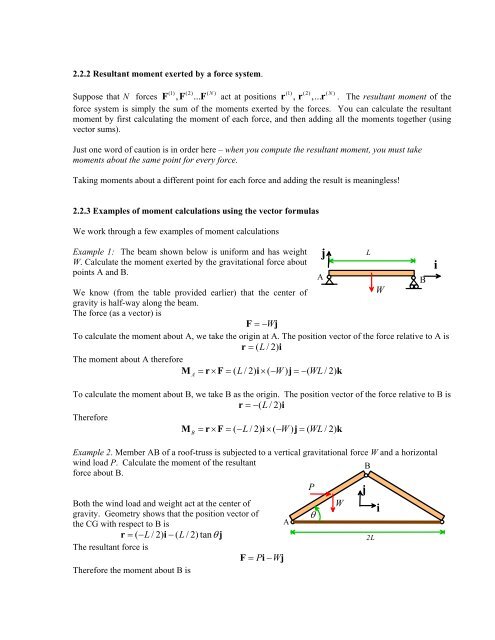Chapter 2 Review of Forces and Moments - Brown University
Chapter 2 Review of Forces and Moments - Brown University
Chapter 2 Review of Forces and Moments - Brown University
You also want an ePaper? Increase the reach of your titles
YUMPU automatically turns print PDFs into web optimized ePapers that Google loves.
2.2.2 Resultant moment exerted by a force system.<br />
(1) (2) ( N )<br />
(1) (2) ( N )<br />
Suppose that N forces F , F ... F act at positions r , r ,... r . The resultant moment <strong>of</strong> the<br />
force system is simply the sum <strong>of</strong> the moments exerted by the forces. You can calculate the resultant<br />
moment by first calculating the moment <strong>of</strong> each force, <strong>and</strong> then adding all the moments together (using<br />
vector sums).<br />
Just one word <strong>of</strong> caution is in order here – when you compute the resultant moment, you must take<br />
moments about the same point for every force.<br />
Taking moments about a different point for each force <strong>and</strong> adding the result is meaningless!<br />
2.2.3 Examples <strong>of</strong> moment calculations using the vector formulas<br />
We work through a few examples <strong>of</strong> moment calculations<br />
Example 1: The beam shown below is uniform <strong>and</strong> has weight<br />
W. Calculate the moment exerted by the gravitational force about<br />
points A <strong>and</strong> B.<br />
We know (from the table provided earlier) that the center <strong>of</strong><br />
W<br />
gravity is half-way along the beam.<br />
The force (as a vector) is<br />
F = −Wj<br />
To calculate the moment about A, we take the origin at A. The position vector <strong>of</strong> the force relative to A is<br />
r = ( L /2) i<br />
The moment about A therefore<br />
MA = r× F= ( L/ 2) i× ( − W) j =−( WL/ 2) k<br />
To calculate the moment about B, we take B as the origin. The position vector <strong>of</strong> the force relative to B is<br />
r = −( L /2) i<br />
Therefore<br />
MB = r× F= ( − L/ 2) i× ( − W) j = ( WL/ 2) k<br />
Example 2. Member AB <strong>of</strong> a ro<strong>of</strong>-truss is subjected to a vertical gravitational force W <strong>and</strong> a horizontal<br />
wind load P. Calculate the moment <strong>of</strong> the resultant<br />
B<br />
force about B.<br />
P j<br />
Both the wind load <strong>and</strong> weight act at the center <strong>of</strong><br />
W<br />
i<br />
gravity. Geometry shows that the position vector <strong>of</strong><br />
θ<br />
the CG with respect to B is<br />
A<br />
r = ( −L/ 2) i−( L/ 2) tanθ<br />
j<br />
2L<br />
The resultant force is<br />
F= Pi−Wj<br />
Therefore the moment about B is<br />
A<br />
j<br />
L<br />
B<br />
i
















